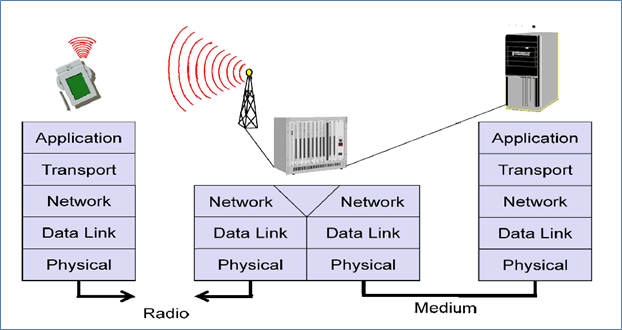Simplified Reference Model of Communication

The above figure shows a personal digital assistant (PDA) which provides an example for a wireless and portable device. This Personal digital assistant communicates with a base station in the middle of the picture. The base station consists of a radio transceiver (receiver and sender) and an interworking unit connecting the wireless link with the fixed link. The communication partner of the Personal Digital Assistant, a conventional computer, is shown on the right hand side. Under earth each network element (such as PDA, interworking unit, computer), the figure shows the protocol stack implemented in the system according to the reference model.
End-systems, such as PDA and computer in the example, need a full protocol stack comprising the application layer, transport layer, network layer, data link layer and physical layer. Applications on the end-systems communicate with each other using the services of the lower layer.
Intermediate systems such as interworking unit; do not necessarily need all of the layers. Above figure shows the network, data link and physical layers. As (according to the reference model) only entities at the same level communicate with each other (i.e. transport with transport, network with network).
Influence of mobile communication to the layer model
| Layers | Key points |
|---|---|
| Application layer |
|
| Transport layer |
|
| Network layer |
|
| Data link layer |
|
| Physical layer |
|
Physical layer
This is the lowest layer in a communication system and is responsible for the conversion of a stream of bits into signals that are transmitted on the sender side. The physical layer of the receiver transforms the signals back into a bit stream. For wireless communication, the physical layer is responsible for generation of the carrier frequency, frequency selection, signal detection (although heavy interference may disturb the signal), modulation of data into a carrier frequency and encryption.
Data link layer
The main tasks of the data link layer include accessing the medium, multiplexing of different data streams, correction of transmission errors and synchronization (i.e. detection of a data frame). In short, the data link layer is responsible for a reliable point to point connection between two devices or a point to multipoint connection between one sender and several receivers.
Network layer
The third layer which is called network layer is responsible for routing packets through network or establishing a connection between two entities over many other intermediate systems. Some topics are addressing, routing, device location, and handover between different networks. The several solutions for the network layer protocol of the internet (the Internet Protocol IP).
Transport layer
Transport layer is used in the reference model to establish an end to end connection. Topics like quality of service, flow and congestion control are relevant, especially if the transport protocols known from the internet, TCP and UDP, are to be used over a wireless link.
Application layer
The applications (complemented by additional layers that can support applications) are situated on top of all transmission oriented layers. Some context on this layer are service location, support for multimedia applications, adaptive applications that can handle the variations in transmission characteristics, and wireless access to the World Wide Web using a portable device. Most demanding applications are video (high data rate) and interactive gaming (low jitter, low latency).
